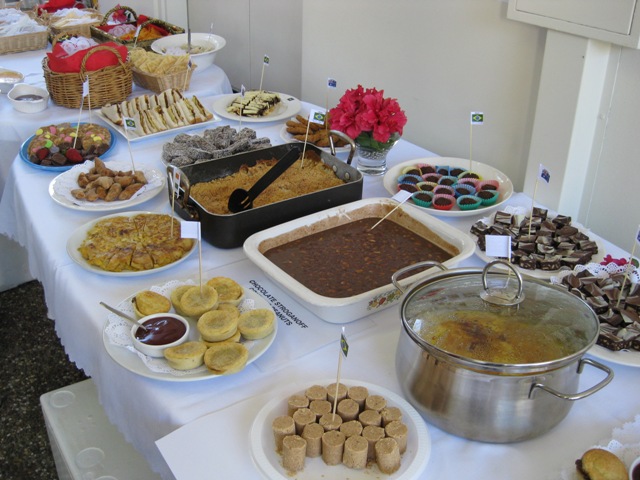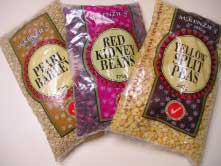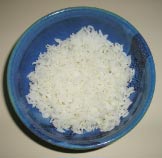PRESENT DIVERSITY USING FOOD!Offer authentic ethnic foods! Many kids have tasted egg rolls, tacos and spaghetti; why not try something from Ethiopia, Thailand, India, Israel or Germany? Help kids make connections between a culture and its food!
Celebrate diversity with an eclectic food feast! This photograph displays a feast where students, Teachers and Staff from AICA in Australia, shared their traditions, food, cultural information and language. (AICA currently has students from 21 different nations)
- Help youth in your program appreciate diversity. Celebrate with an eclectic dinner featuring cuisine from different countries or geographical regions.
- Serve Puerto Rican rice-and-beans, Boston clam chowder, a Chinese stir-fry, and peach pie …The variations on this theme are endless, and the dinner doesn’t need to be time-consuming.
- You can achieve almost the same effect by stopping for TAKEOUT from Kentucky Fried Chicken, Taco Bell, and your local pizza parlor (Italian or Greek).
TWO FRIENSHIP SNACKS
#1 FRIENDSHIP SNACK MIX: Have each child bring in a half cup of their favorite snack (You can offer parents suggestion at this point: cereal, raisins, crackers, etc) When you get all of the snacks– mix them all in a huge bowl and serve them for snack.
Talk about how different things go together to make something very good. This helps get the ideas of diversity, sharing, cooperation, and trying new things across.
#2 Do the same as above, however, USE FRUIT instead of snack mixes. Have each child bring in one can… or piece of fresh fruit…and then talk about how different things go together, to make something very good. This helps get the ideas of diversity, sharing, cooperation, and trying new things across. (Donate any left-over cans to a shelter)
APPLES: DIFFERENT COLORS ALL THE SAME INSIDE
- Set a red, a yellow, and a green apple on the table.
- Ask children to name the colors.
- Cut the apples open and talk about how they have different colors on the outside… but are the same on the inside, just like people. Enjoy the snack!
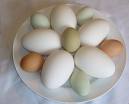
Take a carton of white eggs and a carton of brown eggs. The children will see that the eggs are of different shades and colors. Ask them what they think the insides of the brown eggs look like and what the insides of the white eggs look like. Discuss how people are all different by their appearance on the outside. Then, have a child break open a white egg into a bowl—and child bread a brown egg in to a separate bowl. The concept is that the eggs may all look different on the outside, but the insides are the same, just like us. Make something with the eggs …enjoy!!!
INTERNATIONAL SNACKS
VANILLA MILK SHAKE–AMERICA
This frosty beverage is an AMERICAN classic. Combine 2 cups vanilla ice cream, ¾ cup milk, and 1 teaspoon vanilla extract in a blender. Process until smooth. Makes 6 servings.
MANGO LASSI–INDIA
Chilled yogurt drinks, called lassis, are a favorite drink in INDIA. In a blender process 2 ripe mangoes (peeled and seeded ), 2 cups plain yogurt, and 4 ice cubes. Add milk and honey to taste. Makes 6 servings.
HAM & MELON-ITALY
This snack is eaten as an appetizer in Italy. Cut a cantaloupe in half, cut off the rind, and remove the seeds. Cut each half into 8 thin wedges. Wrap a slice of ham around each melon wedge and serve. Makes 8 servings.
TORTILLAS
Made with either corn or wheat flour, these flat rounds are a staple of the Mexican diet. Combine 2 cups masa harina (corn flour) and 1 teaspoon salt in a large bowl. Gradually add 1 ½ cups warm water and mix with your hands until mixture forms soft dough. Form into 15 equal balls. Flatten each ball into a thin 6-inch circle. Fry tortillas in a dry pan over medium-high heat for about three minutes, turning once. Serve warm. Makes 15 tortillas.
VERMICELLI WITH FRUIT & NUTS–KENYA
- This traditional Kenyan dish shows the influence of European settlers who introduced noodles and other foods many years ago.
- Heat oil in a heavy skillet over medium heat.
- Add 3 cups vermicelli (broken into 1-inch pieces) and saute (until lightly browned.)
- Pour in 3 cups hot water.
- Stir in 1/3 cup sugar, 1/3 cup raisins, 1/3 cup chopped dates, 1/3 cup chopped walnuts, and 1 teaspoon ground cardamom.
- Cover, reduce heat and simmer until water is absorbed, about 10 minutes. Makes 8 servings.
CHILDREN’S COOKING BOOK!
Take a trip around the world and learn about different lands and different cultures with Kids Around the World Cook! by Arlette Braman (2000 John Wiley & Sons).
As noted in schoolage note of the day…”This book is a blend of recipes, facts and historical information. Children can follow easy-to-make recipes for foods such as Mexican Hot Chocolate, Ethiopian Injera, Lebanese Baba Ghanouj, Canadian Prairie Berry Cake and many, many more. ”
OPEN YOUR PROGRAM TO NEW EATING EXPERIENCES!
Choose 1 day a month to try a different type of food. Go through cookbooks with youth and put together a shopping list of…
- International food aisle items…Or, go to the produce department to find fruits and vegetables from other countries to try. You also can go through the newspaper’s local restaurant review section with your kids and choose an ethnic restaurant where you can pick up specialties to try…
- As the children try the new food, talk about how they are the same or different from what they usually eat. What are the different tastes? What are the different ingredients
WORLD MEAL (For older youth through adult ages)
Materials:
Rice and beans–herbs and spices are optional– as is anything you can forage from the local natural environment. Also need basic cooking equipment and eating utensils (e.g., bowls and chopsticks).
Time 30-60 minutes cooking time. Beans should be presoaked for 12 hours
Brief Description
Cook a World Meal and share it with your group.
It is the average meal for the average person on the planet. It consists of a limited amount of rice and beans.
Encourage the group to cook a World Meal for a different group of people and thereby spread experiential awareness of how much we over-consume in Western society. Continue cooking World Meals for groups of people until you’ve activated a critical mass of awareness for a snowball effect.
For remainder of information click here.
***If you are a parent, visit different ethnic neighborhoods to shop in the markets and eat at authentic restaurants. Attend ethnic festivals in your community. Art museums and musical concerts and dance performances often feature multicultural themes.
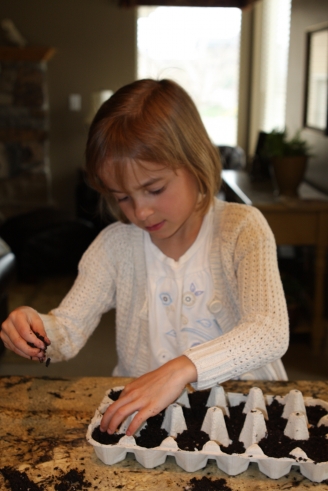
MULTICULTURISM: PLANTING SEEDS
A simple project can demonstrate the beauty of diversity!
- was to see people of all countries, races, and religions living together in harmony.
- Gather seeds of different kinds and invite each student to plant a variety of seeds in an egg carton.
- The seeds of different shapes, sizes, and colors will sprout side by side. Once the plants are large enough, transplant them into a large pot in the classroom or in a small garden outside.
- If you do this project with some of the school classes, each class in the school might do the project on its own, culminating in the creation of a beautiful, colorful, and diverse schoolwide garden! Source: Richard Ellenburg, Orlando, Florida — Learning magazine, January 1994.
UNDERSTANDING PREJUDICES (Middle School-to College) This speaks to diversity–not only cultural–but also diversity in other ways.
- Make up index cards that have descriptions of different types of people. It could cover race, religion, disabilities, whatever you come up with.
- Each person has an index card placed on their back and they don’t know what they have been labeled with. Each person has to guess what their label is by the way others act towards them.
- This could make a more serious activity by having quite a bit of processing afterward to talk about why others acted towards you in a stereotypical way, and how they need to recognize these stereotypes and prejudices that they knew they had or just recognized with this activity.
Bonnie Knapp, University of Iowa
For those of you looking for innovative ways to bring ethnic diversity to your programs, you may want to check out the PEACE CORPS WORLDWISE Schools materials. While a lot of it focuses on education, there are interesting multimedia options too—such as podcasts from Peace Corps volunteers in the field, videos made by students from other cultures, stories, and lesson plans (for those with an academic program). To learn more about what they have, visit their website

(For Middle School and High School)
- Divide kids with girls on one side and boys on the other.
- Alternate sides and ask each person to say something about the other sex.
- When someone says something ‘negative’–put a chair in the middle of the room. When someone says something ‘nice’–remove a chair from the middle of the room. It will consist of standard and stereotypical things, “boys are like this”—- “girls are like that”.
- Eventually there will be a solid straight line of chairs placed back to back and facing outward at each group.
- When complete–have both sides walk up to the chairs, and sit down ON THE FLOOR facing the empty chairs.
• Have the group sit and stare at the empty chair; tell the group that THIS is the wall that we make with our words whenever we talk negatively about others or prejudge others.
• Be upset. Not at them, but at the wall. Show disdain…
• When it’s time, have youth get up and remove the chairs themselves and give them the choice to talk about what they have learned…
If the session is conducted right, it will have a very powerful and positive impact on many kids. If for some reason (hooray) you do not end up with a wall of chairs–talk about how “this group” has grown and understands how gender-bias impacts the world we live in…
TWO DISCRIMINATION LESSONS…
#1 Use with Older Youth: Middle School to High School…
Citizenship/role playing. This common activity is used in classrooms everywhere — but it’s only worth repeating from TIME TO TIME!
The activity helps students understand the concept of “discrimination.”
- For this activity, divide the class into two or more groups. Some teachers divide students by eye or hair color; some invite students to select and wear badges of different colors (purple, green, and other colors that are not related to skin color); and others isolate students whose first names begin with the letter “b,” (or whichever letter is the most common first letter of students’ names in the class).
- For a class period or for an entire school day, one group of students (for example, the kids who have blond hair, those wearing orange badges, or the ones whose names start with “B”) are favored above all others. Those students receive special treats or special privileges, and they are complimented often. Students who aren’t in the “favored” group, on the other hand, are ignored, left out of discussions, and otherwise discriminated against.
IMPORTANT!
At the end of the exercise, students discuss their feelings.
- How did it feel to be treated unfairly, to be discriminated against? Invite students to talk about times when they felt they were judged or treated unfairly. How does this “experiment” relate to the life of Martin Luther King, Jr.?
Source: Kidsphere listserv education-world.com
#2 Teach children about Discrimination: This is a simplified version of the above. While the above is for older youth—this is appropriate for Pr-K all the way up!
Materials: Sign with Rules that will be enforced in various room areas/centers. Prepare signs for: Blue eyes, brown hair, long hair, gym shoes, etc.
First, discuss discrimination:
- What is it?
- How does it feel?
- How hurtful is it?
- The importance of Kindness and treating others as we want to be treated…
- Tell the children that “JUST TO SEE WHAT IT FEELS LIKE” you’re going to “role play” so they can experience what it is like for people who are discriminated against.
When the couple hours are over–BE SURE TO HAVE A DE-BRIEFING, where the children meet in small groups to share their feelings and thoughts. THE PREPARATION AND DEBRIEFING IS IMPORTANT!!!!
Using rebuses (for the kids who can’t yet read) hang or post signs in centers with a picture; put a circle around it with a slash over the entire picture and circle. An example: A picture of a child with “blue eyes” with a circle around it and a slash through it. This means that for the next hour, no one with blue eyes may play in that center. Rotate and change signs.
‘Traveling Around the World’ is a great theme for multicultural experiences as well as popular for classroom, day camp and childcare programs! Category resources available at this time are:
•CHINA •FRANCE •MEXICO •USA-PATRIOTIC •USA-COLONIAL
NATIVE AMERICANS
THE TALKING STONE-or Stick (Use with Pre-K and up!)
Often during circle or group time, many children want to talk at once. One way to help children learn how to take turns is to use a visual clue. Teachers/caregivers might try using a “talking stick” or “talking stone”. This is a tradition with some Native Americans. Hold your ‘stick’ or ‘stone’ while you speak and then pass it on when it’s time for another person to talk.
You can use a colorful rock or decorate your stick in a special way. This technique helps young children learn to respect the speaker and to wait and listen. Continue with this idea and soon the children will be reminding each other.
This version is adapted from preschoolrainbow.org; however, I’ve used this method for the last 20 years when having group meetings with youth. I’ve actually made a “Talking mouth” out of a rolled up pair of white socks and in the past used a stone and feather. It works!!! Until recently, I didn’t know that it has Native American origin. It was something that I just thought of… 20 plus years ago!
Much may surprise you–especially the usual suggested Native American BOOK LISTS (See below) for School-Age children. Visit Cradle Board Teaching Project for activities/ideas. This site is designed and run by American Indians.
If you want to avoid presenting stereotypical activities, check out websites recommended by a former elementary school teacher and enrolled tribal member.
BOOKS that tribal members have asked TO AVOID… (To read a critical review that supports the Indian position, click on Cradle Board Teaching Project.) These are not all the books that they do not recommend; they believe these are some of the worst. For books that are recommended, please view their catalog.
- Carilyn Alarid and Marilyn Markel, Old Grandfather Teaches a Lesson: Mimbres Children Learn Respect. Illustrated by the authors. Sunstone (2005)
- Lynne Reid Banks, The Indian in the Cupboard. Illustrated by Brock Cole. Avon (1980)
- The Return of the Indian. Illustrated by William Geldart. Doubleday (1986)
- Sharon Brown, Kit’s Indian Summer. PublishAmerica (2004)
- Michael L. Cooper, Indian School: Teaching the White Man’s Way. Clarion (1999)
- Alice Dalgliesh, The Courage of Sarah Noble. Illustrated by Leonard Weisgard. Macmillan (1954, 1991)
- Walter D. Edmonds, The Matchlock Gun. Illustrated by Paul Lantz. Dodd, Mead (1941), G.P. Putnam (1989), Penguin Putnam (1998)
- Janet Ruth Heller, How the Moon Regained Her Shape. Illustrated by Ben Hodson. Sylvan Dell Publishing (2006)
- Susan Jeffers, Brother Eagle, Sister Sky. Illustrated by the author. Dial (1991)
- Heather Irbinskas, The Lost Kachina. Illustrated by Robert Albert (Hopi). Kiva (2004)
- Beth Kanell, The Darkness Under The Water. Candlewick (2008)
Also, see the open letter to Beth Kanell. - Tim Kessler, When God Made the Dakotas. Illustrated by Paul Morin. Eerdmans Books for Young Readers (2006)
- Liza Ketchum, Where the Great Hawk Flies. Clarion Books (2005)
- Tanya Landman, I Am Apache. Walker Books (2007)
Also, see accompanying essays. - Albert Marrin, Sitting Bull and His World. Dutton (2000)
Also see the accompanying essay, Turning a Battle Into a Massacre. - Bill Martin and John Archambault, Knots on a Counting Rope. Illustrated by Ted Rand. Holt (1987)
- Ben Mikaelsen, Touching Spirit Bear. HarperCollins (2001)
- Neil Philip, The Great Circle: A History of the First Nations. Clarion (2006)
- Bebe Faas Rice, The Place at the Edge of the Earth. Clarion (2002)
- Ann Rinaldi, My Heart Is On the Ground: The Diary of Nannie Little Rose, a Sioux Girl. Carlisle Indian School, Pennsylvania, 1880. Scholastic (1999), Dear America Series
Also see the accompanying essay, “Literary License” or “Mutated Plagiarism”? - Cynthia Rylant, Long Night Moon. Illustrated by Mark Siegel. Simon & Schuster (2004)
- Debbie and Michael Shoulders, D is for Drum: A Native American Alphabet. Illustrated by Irving Toddy. Sleeping Bear Press (2006)
- Marc Simmons, Millie Cooper’s Ride: A True Story from History. Illustrated by Ronald Kil. University of New Mexico Press (2002)
- Elizabeth George Speare, The Sign of the Beaver. Dell (1983)
- C.J. Taylor, Peace Walker: The Legend of Hiawatha and Tekanawita. Illustrated by the author. Tundra (2004)
- Ann Turner, The Girl Who Chased Away Sorrow: The Diary of Sarah Nita, a Navajo Girl. New Mexico, 1864. Scholastic (1999), Dear America Series
- Neil Waldman, Wounded Knee. Atheneum (2001)
- Kathy Jo Wargin, The Legend of the Petoskey Stone. Illustrated by Gijsbert van Frankenhuyzen. Sleeping Bear Press (2004)
- Laura Ingalls Wilder, Little House on the Prairie. Illustrated by Garth Williams. HarperCollins (1935, 1953, 1981)
The Multi-Cultural/Diversity Category contains six sections. You may scroll through all six, or click on the page you would like to visit. Menu for Diversity and Multicultural Category
- Diversity Theme Introduction & Menu
- Diversity Using Arts & Crafts
- Diversity through Language and Literacy
- Dr. Martin Luther King Jr.
